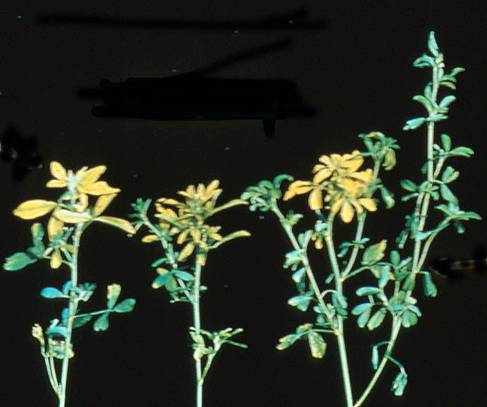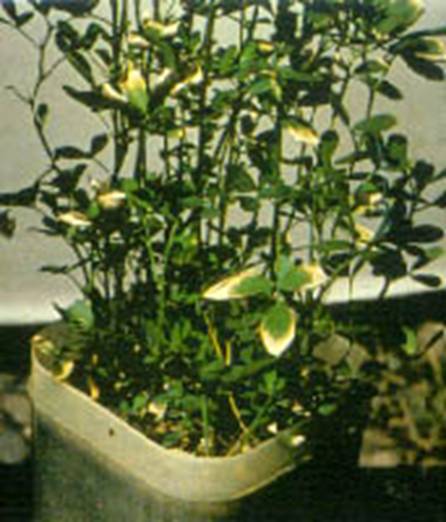Boron (BO3-3 )
Boron in the Soil
Total soil boron (B) content can range from around 20 lb./acre to over 200 lb./acre (10 to 100+ ppm). However, only a small fraction of this amount is available to the crop. Much of the total soil B is present as a component of Tourmaline, a highly insoluble mineral. Most of the remainder is in secondary, moderately insoluble minerals. The forms of B that are available to plants include inorganic borate complexes of Ca, Mg, and Na, plus various organic compounds formed from plant and microbe decomposition.
Functions
Boron is essential for many plant functions. Some of them are
- Maintaining a balance between sugar and starch.
- The translocation of sugar and carbohydrates.
- It is important in pollination and seed reproduction.
- It is necessary for normal cell division, nitrogen metabolism, and protein formation.
- It is essential for proper cell wall formation.
- It plays an important role in the proper function of cell membranes and the transport of K to guard cells for the proper control of internal water balance.
Factors Affecting Availability
- pH: High pH reduces, and low pH enhances availability.
- Leaching conditions: B is mobile, so coarse soils and high rainfall may cause temporary soil shortages.
- Low OM: Organic matter is a reservoir for B, and many other nutrients
- Low Moisture: Boron uptake is in part determined by water uptake rate, therefore drought reduces B uptake. Also, B deficiency reduces root growth, thus aggravating the B stress.
- Soil Ca:B Balance: Some work has indicated that high soil Ca levels, independent of soil pH can reduce B uptake. In most situations however, high soil Ca will be accompanied by higher soil pH, and the pH effect will dominate. In some cases of B toxicity, applications of a soluble form of Ca has reduced the toxic effects.
- K:B Balance: Work has show that high K rates can sometimes depress corn yields if B is limiting.
- Zn:B and P:B Balance: Work with barley showed that Zn applications can reduce B accumulation. This same work showed that high P applications increased B accumulation.
- N Stress: Low N availability decreases the vigor of plants to an extent that it may fail to take up adequate amounts of many other nutrients. Boron uptake can be affected in this way.
High Response Crops
While boron is an essential element for all plants, the following crops have been found to be especially responsive: alfalfa, apples, broccoli, brussel sprouts, cabbage, carrots, cauliflower, celery, citrus, clover, conifers, corn, lettuce, onions, peaches, peanuts, pears, sunflower, sweet corn, sweetpotato, sugarbeets, table beets, tomato, and turnip.
Deficiency Symptoms
Symptoms vary between crop species, but generally occur in the growing points or flower and fruiting parts of the plant. Young leaves will often show a general chlorosis, as is the case with alfalfa. The upper leaves of clover may show a reddish color. In both crops, the terminal internodes shorten, and the new growth may appear distorted. Cotton may exhibit a rosette growth due to shortened terminal growth. Corn may not show any leaf symptoms, but a B deficiency can cause the failure of the pollen tube to function properly. This results in kernel embryos not being pollinated, causing the ears to have missing kernels.
| BORON DEFICIENCY SYMPTOMS | |
|---|---|
| Crop | Visible Symptoms |
| Alfalfa | Death of terminal bud, rosetting, yellow top, little flowering and poor pod set. |
| Almond | Flowers fall and nuts abort or are gummy. |
| Apple | Pitting, skin discolored, cracking and corking. |
| Apricot | Twigs die back and fruit fails to set. |
| Beet (Table) | External spotting, cracking and canker. |
| Broccoli | Hollow stems, internal discoloration, brown curds. |
| Cabbage | Hollow stem, watery areas, heads hollow, plants stunted. |
| Canola | Leaves distorted. Blank or partially filled seed heads. |
| Carrot | Reddening of leaves and root splitting. |
| Cauliflower | Leaves curled, hollow stem, curds dwarfed, brown. |
| Celery | Stem cracked and striped brown, heart blackened. |
| Citrus | Thickened ring, gum pockets near axis, discolored patches. |
| Clover | Poor stands, growth and color. Reduced flowering and seed set. Leaves cupped and shriveled, and become brittle. |
| Corn (all) | Short, bent cobs, barren ears, blank stalks, poor kernel development, elongated, watery or transparent stripes later becoming white on newly formed leaves, dead growing points. |
| Cotton | Shedding of squares and young bolls, ruptures at base of squares, dark fluid exuding from ruptures, internal discoloration at base of boll, half-opened bolls, green leaves until frost. |
| Dry Bean | Interveinal chlorosis of leaves. Bushy appearance. |
| Grape | “Hen & Chick” symptom, dead main shoots. |
| Lettuce | Stunted growth, discoloration of leaves, brittle. |
| Peanut | Dark, hollow area in center of nut, called "hollow heart." |
| Pear | Blossom blast, pitting, internal corking and bark cankers. |
| Pistachio | Fruit set decreases, and blanks and non-split nuts increase. |
| Potatoes | Plants have a bushy appearance. Leaves thicken and margins curl upward. |
| Radish | Pale roots, brittle stems, watery flesh and flecked coloration. |
| Rutabaga | Roots are tough, fibrous and bitter. Upon cutting, they have soft, watery areas, often called "brown-heart." |
| Sorghum | Leaves are narrow and have a gray appearance with watery, transparent stripes. Seed heads are not filled. |
| Soybean | Yellow leaves, chlorotic between veins, downward curling of leaf tips, crinkling of leaves, dieback of tips, no flowering, roots stunted. |
| Strawberry | Pale chlorotic skin of fruit, cracking and dieback. |
| Sugar Beet | Yellowing or drying of leaves, cracking of leaf midrib, brown discoloration of internal tissue, rotting of crown. |
| Sunflower | Leaves appear wilted. Abnormal head fall due to weak peduncles. |
| Tobacco | Leaf puckering and deformed buds. |
| Tomato | Thickened leaves, brittle leaves, fruit fails to set. |
| Turnip | Hollow center or brown heart, watery areas. |
| Walnut | Dieback from shoot tips, leaf fall. |
| Wheat | Distorted heads and chlorosis of leaves. |
Toxicity
The range between a correct application rate, and a toxic one is not large, so it is relatively easy to apply too much boron. Because of this, it is very important to get uniform mixing and application, especially when applying in concentrated bands or foliar. Because of the slow transport of B in the plant, symptoms generally appear on the older leaves and consist of margin or leaf tip chlorosis, browning of leaf tips, which is quickly followed by the death of the affected tissue or defoliation. The critical plant level for toxicity can range from 10 - 50 ppm in sensitive crops such as small grains and garden beans, to as high as 200 ppm in tolerant crops such as sugar beets, rutabaga, cucumbers, and conifers.
Since B is a mobile element in the soil, excess B from over-application can be corrected over time with leaching. Applications of lime and sources of soluble Ca have been shown to be effective in reducing B toxicity, and it has been reported that additional N application can be of benefit.
Using Boron in a Fertility Program
| Recommended rates of B | |
|---|---|
| Method | Pounds of B/Ac |
| Broadcast | 1.0 to 3.0 lb./Ac |
| In-row | Not Recommended |
| Foliar | 0.10 to 0.25 lb./Ac |
Broadcasting is the preferred application method for several reasons.
- Row applications have a higher risk of uneven or excessive application, either in the total effective rate per acre, or from localized hot spots.
- Boron is mobile in the soil, and broadcasting is effective in supplying the crop.
- Broadcasting, unlike foliar, requires only one application per season to adequately supply the crop. It is often sufficient to make a single foliar application of B to perennial crops, such as orchards, vineyards and Christmas trees.
The impregnation of dry fertilizer blends with dissolved Solubor has been successfully used to assure uniform distribution.
If visible B deficiency symptoms appear, significant yield reductions have already occurred. Use plant analysis to identify and correct nutrient shortages before they cause serious yield losses. Also remember, as growers strive for those exceptional yields, the need for B increases.
| Some Boron Fertilizer Sources | ||
|---|---|---|
| Product | Chemical Formula | Approximate B % |
| Borax | Na2B4O7 .10H2O | 11% |
| Boric Acid | H3BO3 | 17% |
| Sodium tetraborate | Na2B4O7 .(0-10)H2O | 10-20% |
| Solubor | Na2B10O16 .0H2O | 20% |


No comments:
Post a Comment